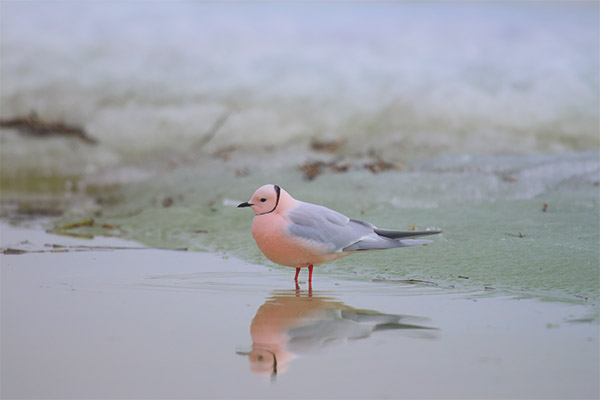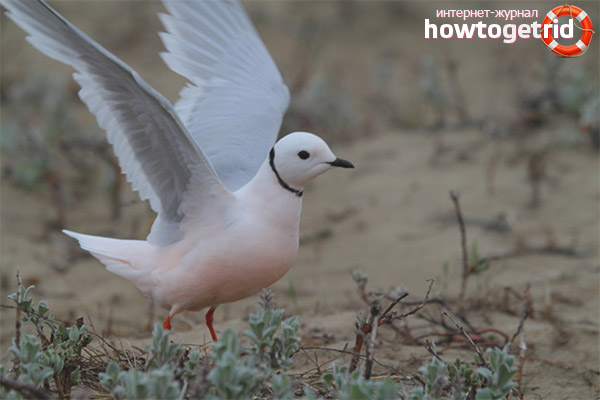The content of the article
There is an old Yakut legend about young girls who considered themselves not beautiful enough, and with all their hearts they wanted to become much more beautiful than they are. They asked for advice from the evil witch in the hope that she would suggest some way to increase the beauty. But the evil witch envied the girls, their youth and freshness. Therefore, of course, she did not advise them anything good. She told the girls to swim in the river in a bitter cold. The witch convinced them that it would bring them unprecedented beauty, and the blush would constantly decorate their faces. Believing the witch, the girls went to the river and dived into the dip, formed in the ice cover. The red sun illuminated the water so that it looked pink. The poor, naive beauties died, and their souls turned into pink gulls, and soared high into the sky.
Appearance
The pink gull in length reaches about 35 cm.Their chest and belly have a delicate pink hue. This beautiful color is harmoniously combined in coloring of a bird with gray-blue in which the back and the head of birds is painted. On their neck they have a black bezel, which looks like a necklace. The beak in representatives of the species is thin, with a curved end.
The main distinguishing feature is the pink color on the belly and chest, as well as the elegant structure of the body. Watching a seagull in flight, one can only wonder at its grace and beauty. The bird soars, without making any sounds, as if it is not difficult for it. Another distinctive feature among the other gulls is a high voice. She can, if desired, make a variety of sounds. The bird does not make these sounds just like that. In this way, pink gulls communicate with each other. By screaming, other individuals understand that the bird is worried about something or, for example, in a rage.
This species can not be called numerous. Birds live in northern Siberia. To see it in nature is difficult because of excessive timidity. In addition, she spends a lot of time hovering over the sea.
Over the past few centuries, as a result of the destructive activity of man, numbers have become ever smaller. In the 19th century, the Eskimos hunted them. Rose gulls served as food for them.At the beginning of the next century, stuffed animals of these beautiful birds became very popular. Local residents caught them, after which they made stuffed animals in large quantities, and the sailors bought and brought them home as a souvenir or sold very expensive.
Today this bird is in the Red Book. Various measures are being taken to preserve the population, and to make it more numerous. Hunting is strictly prohibited. Locations where the bird lives, become reserves.
Lifestyle
They equip the nest near the rivers, as well as in swamps, which are overgrown with dense vegetation. They weave it from small branches and grass. In winter, pink gulls try to stay near the sea, not flying away from nesting sites. In order to have a source of food, they live in groups near the unfrozen parts of the sea.
It is difficult to study all the features of the behavior of these birds, so scientists were not able to do this to the end. The problem is too harsh climate in their habitat.In addition, these birds are very shy and they try not to show themselves to humans. Many descriptions of this species are based on the assumption of scientists, which are based on the behavior of other gull species.
They migrate very far from the sea coast, so this phenomenon is also extremely difficult to observe. But some researchers did make desperate attempts to find out as much as possible about the behavior of rosé gulls. It is known that the nesting area they most often leave in the first half of August. Different in age individuals soar, and are sent in different directions.
During the migration period, birds spend a lot of time in flight. Sometimes they are overtaken by a storm, which causes the bird to lose its course.
Nutrition
During the nesting period, and also when the chicks are still very small, their food is terrestrial feed. They eat insects, various invertebrates living in rivers, as well as small fish.
If a bird cannot find enough animal food, it can also feed on vegetation. She eats green plants, as well as their seeds. They are almost omnivorous. Therefore, if there is no food nearby that suits their taste, then they bite off any suitable food,found on water, in air or on ice surface.
During nesting, pink gulls seek food as close to their nests as possible. Looking for terrestrial insects, invertebrates. This period they do not spend in flight, looking for food, and move on foot to find a treat that hides in the dry leaves.
If gulls do not find food, they can move closer to human settlements to search for food in garbage dumps. When in summer the air becomes warm enough and a large number of mosquitoes appear, the birds begin to feed only on them, returning to the air hunt.
When the pink gulls are above the sea, they hunt away from the ice. They sit on the water and look for insects on its surface. If she notices a prey in the water that floats past her, then she dives in whole or in part to catch her. If there is enough food around the bird’s habitat, but its quantity is very limited, the bird will actively drive other birds away from this territory.
Breeding
These birds arrive to the nesting site by the end of spring or with the beginning of summer.The pink gull picks up a suitable place where you can equip the nest, and begins to prepare it. Their nest is usually very neat, it lines it with small twigs, foliage and grass. She tries to use any suitable materials to make the chicks as comfortable and as good as possible. During this period, their nests and other seagulls are not far from each other.
Most often in laying there are 3 eggs. For three weeks, gulls hatch them carefully. Both female and male are involved in the process. They replace each other to alternately warm the future offspring. When one of them is sitting on eggs, the second goes in search of food to eat.
At the end of June, small chicks squeak in the nest. If the birds started nesting a little later, then this can happen in early July. The pink gull chicks very quickly adapt to the difficult conditions of the tundra. They remain unattended with adult birds, warming each other with their bodies. At the age of three weeks, the birds can already fly perfectly.
With the beginning of the molt, the family of pink gulls gathers in groups to go closer to the sea.Here, young individuals learn to hunt on their own, adapting to the harsh climate.
Representatives of the species live about 12 years. But science can not reliably name the duration of their life, as the species is not studied well enough.
Video: pink gull (Rhodostethia rosea)












To send